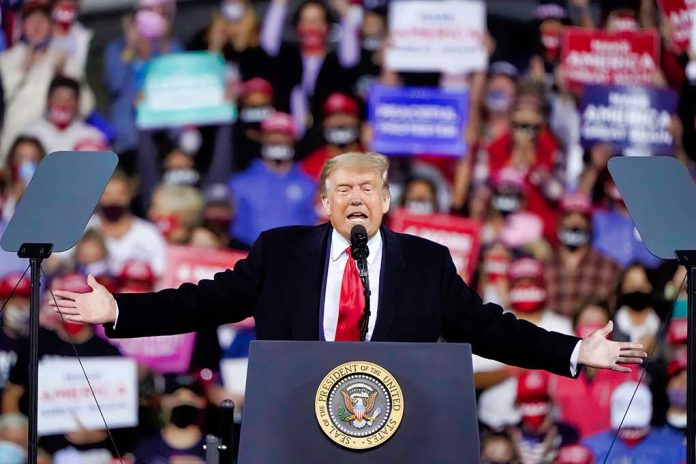
Donald Trump’s proposed executive order to combat inflation and stabilize consumer prices has garnered significant attention.
At a Glance
- Donald Trump promises to end inflation and reduce consumer prices if re-elected.
- Proposed policies include tariffs, tax cuts, and immigration changes, which some economists warn could drive inflation higher.
- Middle-class households could face additional annual costs due to proposed tariffs.
- Trump’s regulatory rollbacks have benefited American families and businesses, raising household incomes and saving billions.
Trump’s Plan to Tackle Inflation
Former President Donald Trump has announced a comprehensive plan to fight inflation, emphasizing his intention to use an executive order for rapid economic stabilization. The plan involves directing cabinet secretaries and federal agencies to utilize all available resources to curb inflationary pressures and provide relief to American families.
If re-elected, Trump vows to bring inflation under control by implementing strategic measures aimed at reducing consumer prices. However, his policy proposals, including tariffs, tax cuts, and strict immigration controls, have raised concerns among economists who argue they may inadvertently fuel inflation.
“‘On my first day back in the Oval Office, I will sign an executive order directing every cabinet secretary and agency head to use every tool and authority at their disposal to defeat inflation and to bring consumer prices rapidly down,’ the 45th president said.”
According to Wall Street economists, Trump’s proposed tariffs—an additional 10% on all U.S. imports and a 60% tax on Chinese products—could act as a consumption tax, raising the cost of imported goods. This increase in cost would likely be passed on to consumers, further contributing to inflationary pressures.
Potential Economic Impact
Corporate tax cuts are another element of Trump’s economic strategy, intended to stimulate business investment and growth. However, these cuts could also act as an inflationary fiscal stimulus, increasing disposable incomes and subsequently driving up demand and prices.
The Council of Economic Advisers (CEA) estimates these actions will raise real incomes by over $3,100 per household per year.
Middle-class households, in particular, are expected to face an additional $1,700 a year in costs due to the tariffs on U.S. imports. Lower-income families could also see a disproportionate impact from higher prices, as they spend a larger share of their income on necessities compared to wealthier households.
BREAKING: President Trump just issued an executive order "on Addressing the Threat Posed by TikTok." It takes effect in 45 days, prohibits "any transaction" with ByteDance, the Chinese company that owns TikTok, and will almost certainly face legal challenges. pic.twitter.com/Ma9XOfYgOB
— Hunter Walker (@hunterw) August 7, 2020
Economists’ Concerns
Economists note that Trump’s new tariff plans are more rigorous than those implemented during his first term, potentially leading to greater economic ramifications. Deporting immigrants could also disrupt the labor market, driving up wages in a manner that contributes to inflation.
Nevertheless, Trump’s regulatory rollbacks have previously benefitted American families and businesses. Between FY 2017 and FY 2019, nearly eight regulations were cut for every new regulation added. These cuts have resulted in significant economic benefits, estimated to save consumers and businesses over $220 billion annually.
Regulatory reforms contributed to a strong labor market and economy before the pandemic, lifting over two million Americans out of poverty and freeing seven million from food stamps.
As the 2024 presidential election approaches, Trump continues to lead in the polls, partly due to voter confidence in his economic strategy. An NBC News poll shows Trump leading Biden nationally by 46% to 44%, highlighting the strong support for his inflation-combat plans.
Sources
1. Trump lays out plan for combating inflation during ‘intellectual speech’ in North Carolina
2. President Trump’s Regulatory Relief Helps All Americans









